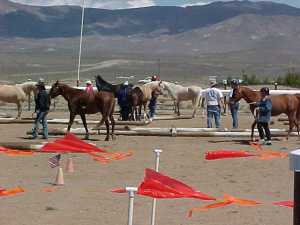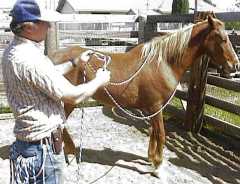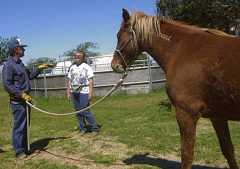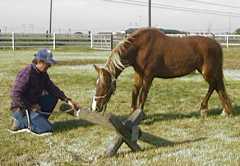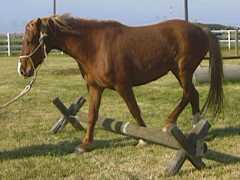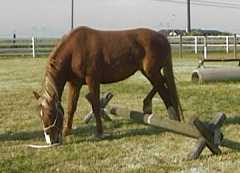Horse Training Mythbusters
|
Horses mentally engaged on the bomb proofing course
|
|
Please note: This discussion starts in Part One. If you entered this site at this page, please start at the beginning.
Lick, chew, swallow = digesting a thought? |
|
Just about everyone who has studied natural horsemanship has observed what we call the lick / chew response when a horse completes a task it is learning and "lets down." A common expression used to describe this behavior is that the horse is "digesting a thought."
This expression is interesting and to some degree it may be correct. Where novice and even some professional handlers blow it is that they really don't understand precisely what thought the horse is digesting. Here is the critical error being made by many horse handlers can be illustrated using a longeing example. The handler applies pressure to the horse and at some point the horse responds. The handler directs some kind of energy towards the horse and at some point the horse sets out on a flight path (e.g., moves out into a circle) until something changes in the horse's perspective and the horse stops. Oftentimes, particularly if the handler becomes quiet, the horse will relax slightly and will lick and chew. At this point a handler, particularly one who is a subscriber to the "digesting a thought" axiom, may then believe that he or she has taught the horse something. Unfortunately, oftentimes there is little connection between what the handler did and horse's response (licking and chewing,) and what (if anything) the horse just learned. |
"Lick / chew" does not necessarily mean that the horse has learned something.During the early moments of "gentling" this horse gets used to a rope put lightly about her neck. Her lick / chew response doesn't mean that she has learned anything about the rope, but rather that she has relaxed in her apprehension over the presence of the rope
|
|
Sue McDonell, PhD, is an established academic in the field of equine behavior. She is the founding head of the Equine Behavior Program at the U. of Penn. school of Veterinary Medicine. She also works with relatively unsocialized horses and teaches novices to gentle "wild" horses. She recently wrote about the lick / chew response in the December, 2005 issue of The Horse.
We found Dr. McDonnell's article to be most relevant as it explained in scientific terms what we were experiencing. The lick / chew reflex is most often what is known as a form of displacement behavior. Displacement behavior is a form of autonomic behavior that is out of context, i.e., licking and chewing when clearly no food is available. In her article Dr. McDonnell presented an analogy to which we all should be able to relate, paraphrased as follows: |
The horse being pursued will lick / chew in relief once the more alpha horse in pursuit is no longer a threat.
|
|
You are driving your car and notice in your mirror the flashing lights of a police car directly behind you. We've all experienced that kind of cold sweat "rush" so I don't need to describe it. Since this isn't the Saturday night episode of COPS you instinctively find a spot to pull over.
In this analogy you then observe the patrol car swinging past you in pursuit of other prey. As a sane person you would experience a tension release that is often accompanied by other phenomenon such as a tingling scalp or itchy neck that you may subconsciously scratch. When the horse is pressured in a confined space (where he cannot take flight and is conditioned not to fight the handler) he is experiencing the equine equivalent of being pursued by the patrol car. In many instances the handler fails to give the horse the opportunity to "pull over." Eventually the pressure stops and the horse displays his programmed automatic displacement behavior, licking and chewing. The horse's display in the example above is clearly one of relief that the pressure has been taken off. Unfortunately many handlers, in search of affirmation of their training prowess, are convinced that lick / chew means that they have just taught the horse something. |
Observing "lick / chew" does have value.This mustang was getting tense during her first walk outside her gentling pen. Stopping in a secure place and allowing her to relax, lick and chew before continuing is a logical application of stress management.
|
|
Countless times we've become involved in situations where horses are exhibiting dangerous behaviors. We most often find a handler relentlessly pursuing the poor animal but convinced that he/she is training correctly because the horse constantly licked and chewed after each assault so therefore the handler must have been teaching the horse something.
"And what else happened?" "Well, he reared and struck me with his foreleg once, and twice he bit me on the top of my head." "Hmmm... What we have here is a failure to communicate." (A failure on the part of the handler, not the horse. It now appears that the horse is getting his point across.) We've also encountered similar situations where the handler was basically attempting to use correct approaches, however the horse was so conditioned to relentless pressure from its previous handlers that it had developed an undesirable conditioned response that carried over to its new owner or handler. We're not trying to argue that the lick / chew response doesn't sometimes equate to, "Aha! I think I've got it!" When setting up horse puzzles we often see a horse curiously engaged in a log maze or some other challenge, he figures it out and then licks and chews. However when one listens to the total conversation (looks at the total horse) one tends to notice that the "puzzle solver" holds himself more erect (and proud?) when licking and chewing when the harried horse displays more of a "beaten down," relieved posture. Ergo we could conclude that licking and chewing are exhibitions of the horse's release from stress and also release from concentration. In simple observations of average handlers "training" horses, it seems clear that most of the licking and chewing are the result of release from stress and relatively little licking and chewing are the result of the horse concentrating and finding the right answer. Therefore each of us who trains a horse should never assume that lick / chew equates to the horse actually understanding what it is we were attempting to teach unless it is accompanied by other clear indicators that the horse is actually solving the problem, not merely relieved that we have let up on the pressure. |
The horse's entire body language, not merely "lick / chew," tells the real story.This horse is curious but her body language discloses some anxiety about the object.
|
Please continue to Part Three
Return to Part One
|
To view a case study example in order to gain a better understanding as to how to use lick / chew as a reliable indicator in potentially stressful situations, please
click here.
For other related information, please see the features: |
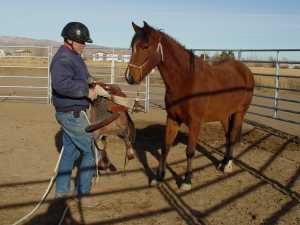
|
Press "Back" to return to the page that brought you hereGo to Case Study SectionReturn to Training SectionReturn to Wild Horse MentorsReturn to KBR World of Wild Horses and BurrosGo To
|

